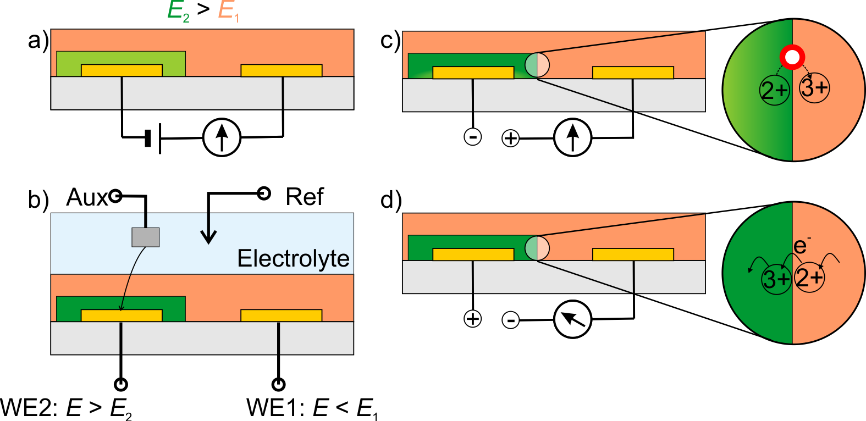Integration of different conductive coordination network compounds in multi-electrode device structures
| Consortium: | |
| Prof. Dr. Gunther Wittstock, Oldenburg Carl von Ossietzky University of Oldenburg Department of Chemistry, Chair of Physical Chemistry - Electrochemistry and Condensed Matter Interfaces | |
| Lena Harms PhD Student | |
| Aditi Chiring Associated PhD Student | |
| Project: | Integration of different conductive coordination network compounds in multi-electrode device structures |
| Abstract: | This project will focus on the integration of different redoxaktive and conductive coordination network compounds (CCNCs) as thin films on multi-electrode devices as active materials for electronic and electrochemical devices. In the first funding period we developed the preparation of crystalline films on the basis of metal hexacyanometallate on different Substrates. In this project we would like to combine the approaches in order to deposit CCNCs with different redox potentials on top of each other. Electrochemical methods and X-ray photoelectron spectroscopy will be used for the characterization of the interface or interphase between such materials. They will provide the elemental distribution, the distribution of valence states as well as the redox potentials of the components in the multi-compound layers. The interphase will also be investigated by transmission electron microscopy (TEM) in a liquid cell, in order to gain insight into the extent and structure of those layers and to understand their role in electrochemically triggered valance changes. Depending on the redox state of the layers, they can or cannot accept/donate charge carriers from the neighboring CCNC phase. Dies will enable to tune the conductivity across such interfaces/interphases by changing the redox state of the CCNCs by voltammetric methods via the contact electrodes on the substrate or by oxidizers or reductants in the liquid phase. This shall be tested by interdigitated electrode arrays. While the change of the redox state of a CCNC by a microbandelectrode is unlikely to be permanent because charge carrier mobility will tend to dissipate those structures, more permanent structures will be created by exchange of transition metal ions and ligands at the surface of such thin films. This will open new possibilities for structural and functional modification of such functional layers, for instance to integrate sensory and photonic functionalities into such multi-component CCNC. |
| Publications: | |
| Obtained with SPP 1928P. Hosseini, G. Wittstock, I. Brand “Infrared spectroelectrochemical analysis of potential dependent changes in cobalt hexacyanoferrate and copper hexacyanoferrate films on gold electrodes" J. Electroanal. Chem. 2018, 812, 199-206 DOI: 10.1016/j.jelechem.2017.12.029 | |
| Obtained with SPP 1928 P. I. Scheurle, A. Mähringer, A. C. Jakowetz, P. Hosseini, A. F. Richter, G. Wittstock, D. D. Medina, T. Bein “A highly Crystalline Anthracene-based MOF-74 Series featuring Electrical Conductivity and Luminescence” Nanoscale 2019, 11, 20949-20955 DOI: 10.1039/c9nr05431f | |
| S. Sauter, G. Wittstock “Local Deposition and Characterisation of K2Co[Fe(CN)6] and K2Ni[Fe(CN)6] by Scanning Electrochemical Microscopy” J. Solid State Electrochem. 2001, 5, 205-211 DOI: 10.1007/s100080000137 | |
| S. Sauter, G. Wittstock, R. Szargan „Localisation of electrochemical oxidation processes in nickel and cobalt hexacyanoferrates investigated by analysis of the multiplet patterns in X-ray photoelectron spectra„ Phys. Chem. Chem. Phys. 2001, 3, 562-569 DOI: 10.1039/b008430l | |
| A. Lesch, B. Vaske, F. Meiners, D. Momotenko, F. Cortés-Salazar, H. H. Girault, G. Wittstock “Parallel Imaging and Chemical Template-Free Patterning of Self-Assembled Monolayers with Soft Linear Microelectrode Arrays” Angew. Chem. Int. Ed. 2012, 51, 10413-10416 DOI: 10.1002/anie.201205347 |
